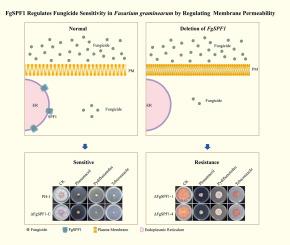FgSPF1通过调节毒素体的形成和膜的通透性来调节谷草镰刀菌DON的生物合成和杀菌剂的敏感性
IF 4
1区 农林科学
Q2 BIOCHEMISTRY & MOLECULAR BIOLOGY
引用次数: 0
摘要
引起镰刀菌头疫病(FHB)的禾谷镰刀菌(Fusarium graminearum)通过产生脱氧雪腐镰刀菌醇(DON)等真菌毒素,降低作物产量并损害小麦质量。虽然SPF1在酵母中保存内质网膜完整性和确保跨膜蛋白质量方面的作用已经得到了很好的研究,但它在农业上重要的植物病原真菌(如F. graminearum)中的作用仍未得到充分的研究。在这里,我们证明了FgSPF1,酵母SPF1在F. graminearum中的同源物,在调节DON生物合成和杀菌剂敏感性中起关键作用。ΔFgSPF1突变体对小麦的毒力降低,DON产量显著减少,这直接归因于毒体结构的破坏。值得注意的是,ΔFgSPF1突变体对七种不同靶点的杀菌剂的敏感性降低。在机制上,LC-MS分析、电导率测量和超微结构观察显示ΔFgSPF1菌株增强了细胞膜致密性,降低了膜通透性,导致杀菌剂吸收减少,从而提高了多种杀菌剂的抗性。此外,由于肌动蛋白极性破坏和菌丝形态改变,FgSPF1的破坏会损害营养生长,减少无性产孢,并消除有性繁殖。总之,本研究确定了FgSPF1在禾谷镰刀菌致病性和杀菌剂敏感性中的一种新的调控机制。本文章由计算机程序翻译,如有差异,请以英文原文为准。

FgSPF1 regulates DON biosynthesis and fungicide sensitivity in fusarium graminearum by regulating toxisome formation and membrane permeability
Fusarium graminearum, which causes Fusarium head blight (FHB), reduces crop yield and compromises wheat quality by producing mycotoxins such as deoxynivalenol (DON). While SPF1 is well studied for preserving ER membrane integrity and ensuring transmembrane protein quality in yeast, its role in agriculturally important plant-pathogenic fungi like F. graminearum remains largely unexplored. Here, we demonstrate that FgSPF1, the ortholog of yeast SPF1 in F. graminearum, plays a pivotal role in regulating DON biosynthesis and fungicide sensitivity. ΔFgSPF1 mutants exhibited reduced virulence on wheat and significantly decreased DON production, which was directly attributed to the disruption of toxisome structure. Notably, ΔFgSPF1 mutants exhibited decreased sensitivity to seven types fungicides with distinct target site. Mechanistically, LC-MS analysis, conductivity measurements, and ultrastructural observations revealed that ΔFgSPF1 strains had enhanced cell membrane compactness and reduced membrane permeability, leading to decreased fungicide absorption and thus increased multi-fungicide resistance. Additionally, disruption of FgSPF1 impaired vegetative growth, reduced asexual sporulation, and abolished sexual reproduction due to actin polarity disruption and hyphal morphological changes. Collectively, this study identified a novel regulatory mechanism of FgSPF1 in pathogenicity and fungicides sensitivity of F. graminearum.
求助全文
通过发布文献求助,成功后即可免费获取论文全文。
去求助
来源期刊
CiteScore
7.00
自引率
8.50%
发文量
238
审稿时长
4.2 months
期刊介绍:
Pesticide Biochemistry and Physiology publishes original scientific articles pertaining to the mode of action of plant protection agents such as insecticides, fungicides, herbicides, and similar compounds, including nonlethal pest control agents, biosynthesis of pheromones, hormones, and plant resistance agents. Manuscripts may include a biochemical, physiological, or molecular study for an understanding of comparative toxicology or selective toxicity of both target and nontarget organisms. Particular interest will be given to studies on the molecular biology of pest control, toxicology, and pesticide resistance.
Research Areas Emphasized Include the Biochemistry and Physiology of:
• Comparative toxicity
• Mode of action
• Pathophysiology
• Plant growth regulators
• Resistance
• Other effects of pesticides on both parasites and hosts.

 求助内容:
求助内容: 应助结果提醒方式:
应助结果提醒方式:


